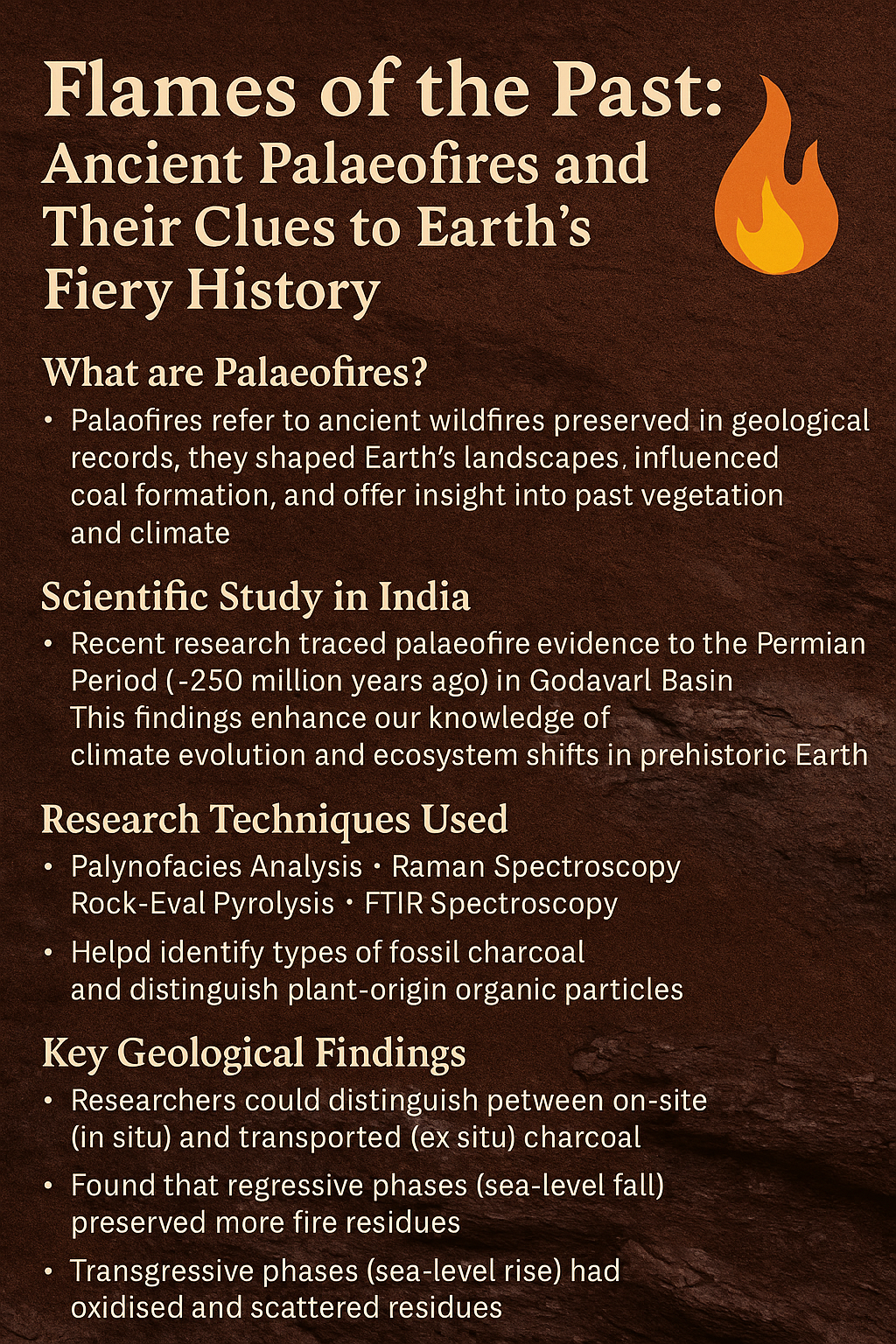
📅 May 9, 2025, Post 8: 🔥 Flames of the Past: Ancient Palaeofires and Their Clues to Earth’s Fiery History | Mains Essay / Target IAS-26 MCQs Attached: A complete Package, Dear Aspirants!
🔥 Flames of the Past: Ancient Palaeofires and Their Clues to Earth’s Fiery History

NEWS DROP — PETAL 008
🗓️ Date: May 9, 2025
🌋 Thematic Focus: GS1 – Geography | GS3 – Environment & Climate Science
🌿 Intro Whisper:
Before humanity lit the first spark, Earth had already burned—and recorded it in its rocks.
🔥 What are Palaeofires?
- Palaeofires refer to ancient wildfires preserved in geological records.
- These fires shaped Earth’s landscapes, influenced coal formation, and offer insight into past vegetation and climate.
🧪 Scientific Study in India
- Recent research traced palaeofire evidence to the Permian Period (~250 million years ago) in the Godavari Basin.
- Site: Raniganj Coalfield
- These findings enhance our knowledge of climate evolution and ecosystem shifts in prehistoric Earth.
🧫 Research Techniques Used
- Palynofacies Analysis: Categorized organic matter in sedimentary rocks
- Raman Spectroscopy
- Rock-Eval Pyrolysis
- FTIR Spectroscopy
➤ Helped identify types of fossil charcoal and distinguish plant-origin organic particles
🧱 Types of Organic Particles Identified
- TrOM (Translucent Organic Matter): Pollen grains, leaf tissues, plant debris
- PAL-CH (Palaeofire Charcoal): Charred plant particles indicating direct wildfire evidence
- OX-CH (Oxidised Charcoal): Possibly transported charcoal, post-burning reworked debris
🧭 Key Geological Findings
- Researchers could distinguish between on-site (in situ) and transported (ex situ) charcoal
- Found that regressive phases (sea-level fall) preserved more fire residues
- Transgressive phases (sea-level rise) had oxidised and scattered residues
🌍 Fire, Oxygen, and Permian Earth
- High atmospheric oxygen levels in the Permian increased wildfire frequency
- Suggests prehistoric Earth experienced frequent, seasonal fire events
- Charcoal layers in Raniganj indicate drought-induced fires in ancient swamps (palaeomires)
🔁 Implications for Modern Climate Studies
- Palaeofire studies help in understanding carbon sequestration and natural carbon cycling
- Insights from ancient fires contribute to palaeoclimate reconstructions
- Such findings can inform climate mitigation strategies in the present age
🔬 Future Directions
- Investigate more coal basins for palaeofire evidence
- Study links between ancient fire regimes and long-term climate transformations
📘 GS Paper Mapping:
- GS Paper 1: Geographical Phenomena | Environmental Change | Stratigraphy
- GS Paper 3: Climate Science | Disaster and Mitigation | Carbon Sequestration
- Essay: “When Earth Burned Itself: Palaeofires and the Legacy of Natural Catastrophe”
🌠 Closing Thought:
In the silent layers of stone lie echoes of flame—reminders that Earth’s past is not just a history of life, but a record of fire.
Target IAS-26: Daily MCQs :
📌 Prelims Practice MCQs
Topic:
MCQ 1: Type-1 — “How many of the above statements are correct?”
Consider the following statements regarding palaeofires and the recent discoveries in India:
1. Palaeofires are preserved wildfire events from Earth’s geological past.
2. The study in the Godavari Basin revealed palaeofire evidence from the Jurassic Period.
3. Palynofacies analysis and FTIR Spectroscopy were used to examine organic matter in the study.
4. Regressive phases led to better preservation of fire residues than transgressive phases.
A) Only two
How many of the above statements are correct?
B) Only three
C) All four
D) Only one
🌀 Didn’t get it? Click here (▸) for the Correct Answer & Explanation
✅ Correct Answer: B) Only three
🧠 Explanation:
1) Correct – Palaeofires are ancient wildfire events recorded in sedimentary layers.
2) Incorrect – The study refers to the Permian Period, not Jurassic.
3) Correct – These techniques were used to analyse fossil charcoal and organic matter.
4) Correct – Regressive phases preserved fire residues more effectively.
MCQ 2: Type-2 — Two-Statement Assertion
Consider the following statements:
1.High atmospheric oxygen levels during the Permian Period contributed to increased wildfire frequency.
2.Oxidised charcoal particles found in sediments indicate reworked or transported fire residues.
A) Only 1 is correct
B) Only 2 is correct
C) Both are correct
D) Neither is correct
🌀 Didn’t get it? Click here (▸) for the Correct Answer & Explanation
✅ Correct Answer: C) Both are correct
🧠 Explanation:
1) Correct – Elevated oxygen levels in the Permian made Earth more fire-prone.
2) Correct – OX-CH (oxidised charcoal) likely indicates transported or reworked material post-burning.
MCQ 3: Type-3 — “Which of the above statements is/are correct?”
Consider the following statements regarding findings and significance of palaeofire research:
1. In situ charcoal refers to fire residues that formed and remained in the same location.
2. The study helps in understanding past climate and vegetation patterns.
3. The research has no relevance to modern climate change or carbon sequestration.
4. Fossil charcoal analysis aids in reconstructing palaeoenvironmental conditions.
Which of the above statements are correct?
A) 1, 2 and 4 only
B) 1, 3 and 4 only
C) 2, 3 and 4 only
D) All four
🌀 Didn’t get it? Click here (▸) for the Correct Answer & Explanation
✅ Correct Answer: A) 1, 2 and 4 only
🧠 Explanation:
1) Correct – In situ charcoal was formed and preserved at the same site.
2) Correct – It reveals ecological and climatic data from the past.
3) Incorrect – It has modern relevance for carbon cycle studies and climate strategy.
4) Correct – Fossil charcoal is a key proxy for palaeoclimate research.
MCQ 4: Type-4 — Direct Factual Question
Which of the following geological sites in India provided evidence of Permian-period palaeofires?
A) Talcher Coalfield
B) Raniganj Coalfield
C) Jharia Coalfield
D) Singrauli Basin
🌀 Didn’t get it? Click here (▸) for the Correct Answer & Explanation.
✅ Correct Answer: B) Raniganj Coalfield
🧠 Explanation:
B) The palaeofire study was conducted in the Raniganj Coalfield of the Godavari Basin.


















